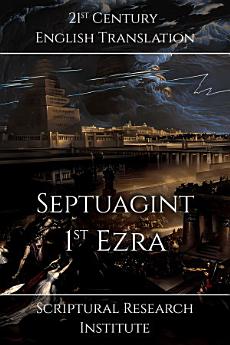Septuagint: 1ˢᵗ Ezra
About this ebook
The Septuagint's 1ˢᵗ and 2ⁿᵈ Ezra are thematically similar, telling the generally same story, however from two different points of view. They tell the story of the fall of Jerusalem, first to the Egyptians, and then the Babylonians, followed by Babylon's fall to the Persians, following which the Judahites returned to Judah and rebuilt the temple in Jerusalem. 1ˢᵗ Ezra was clearly written from a non-spiritual viewpoint, common among the Sadducees, and repeatedly makes it clear that the author, Ezra, and various kings, viewed the Lord as the Judahite version of other gods, including the Egyptian creator and Sun-god Atum, and the Zoroastrian 'god of truth' and 'King of the Sky' Ahura Mazda. These views are inconsistent with the view of the Pharisees, which developed under the rule of the Hasmonean dynasty after Judea broke free from the rule of the Greeks, and the Lord became a separate god from all others.
Both the Greek translations of 1ˢᵗ and 2ⁿᵈ Ezra, and the Hebrew translation of Ezra-Nehemiah (2ⁿᵈ Ezra), contain relics of an Aramaic source-text, unfortunately, the Aramaic Book of Ezra is lost. The difference in the surviving Aramaic words within the Greek 1ˢᵗ Ezra, and Hebrew Ezra-Nehemiah, it appears that the two versions of Ezra already existed in the Aramaic versions. 1ˢᵗ Ezra, the less spiritual of the two, clearly dates to the Persian era, as it treats the Judahite Lord of the Temple in Jerusalem as another version of Ahura Mazda, the Zoroastrian God. Several Zoroastrian titles of Ahura Mazda are applied to the Judahite Lord, including King of Truth, and King of the Sky. Letters from the Persian Kings Cyrus II, Artaxerxes I, and Darius II, as included in the book, all of which were closely associated with Zoroastrianism, yet, referred to the Judahite Lord using titles generally associated with Ahura Mazda. In the Greek 1ˢᵗ Ezra and 2ⁿᵈ Ezra, and the Hebrew Ezra-Nehemiah, the temple is described as being a Zoroastrian fire-temple, containing an eternal fire, which Nehemiah even referred to as burning naphtha, like the other fire-temples across the Persian Empire.











